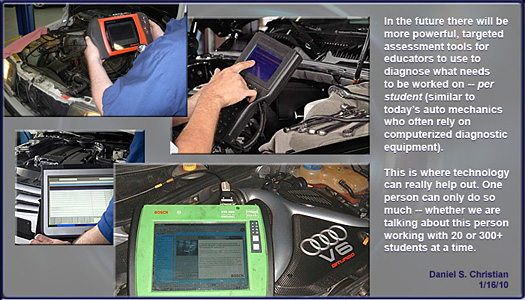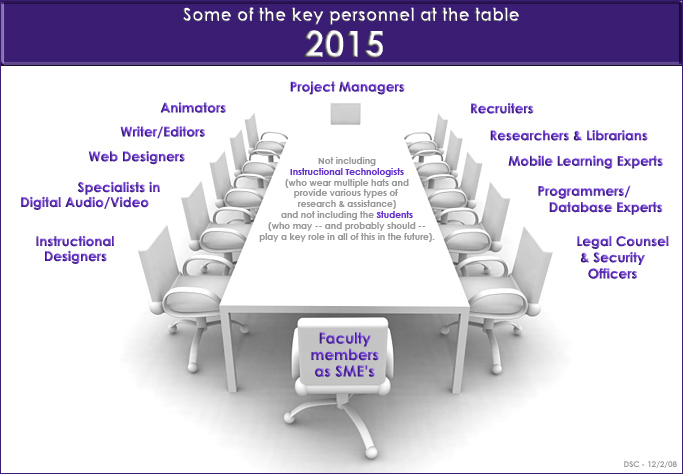.
.
Excerpt:
Now one university is working with a major educational content company to shift some of that accountability from the institutions that enroll students in courses to the companies that supply them with educational texts and tutoring software.
From DSC:
As Brian Crosby points out in the title of his blog — “Learning is Messy.”
There is no silver bullet in the world of education that can be used to effectively teach everyone. In fact, if you were to get 100 instructional designers/teachers/professors/instructors/trainers in the same room, you will not be able to find anything close to a strong agreement on what constitutes the best and most effective learning theory as well as the practical implementations of applying that learning theory (even if we were to be talking about the same age range of students). In my Master’s work, I was looking for that silver bullet…but I never found one.
It is very difficult for a professor or a teacher to deliver truly personalized/customized learning to each student in their classroom:
In my estimation, the way we have things setup throughout most K-16 education, this is an impossible task. When there’s typically only 1-2 teachers trying to teach to 20-30 students at a time, how can this type of personalized instruction occur?
However, I believe digital learning and its surrounding tools/ecosystems hold enormous promise for delivering truly customized/personalized learning opportunities. Such technologies will be able to learn where a student is at, how to motivate them, how fast to push them, and how they best progress through a type of content. Such tools will provide real-time, learning-related, diagnostic dashboards for professors or teachers to leverage in order to guide and optimize a student’s education.
.

.
So I believe that the promise is there for delivering truly customized/personalized learning opportunities available 24x7x365 — even though we aren’t completely there yet. But think of the power a teacher would have if he or she had IBM’s Watson AI-based analysis on each student at their disposal! A “guide on the side” using such diagnostic tools could be a ***potent*** ally for a student.*
As such, I see innovative approaches continuing to come to fruition that will harness the power of serious games, analytics, web-based learner profiles, and multimedia-based/interactive learning content. Eventually, a piece of this type of personalized education will enter in via the Smart/Connected TVs of our living rooms…but that’s a post I’m building out for another day in the near future.
.
*Another hope I have here is that such technologies will
enable students to identify and pursue their passions.
Some items that reinforced this notion for me include:
The key link from Bloom (1913-1999) one e-learning paper you must read plus his taxonomy of learning — an excellent item from Donald Clark Plan B (also see Donald’s archives for postings re: 50 top learning theorists)
The 2 Sigma Problem: The Search for Methods of Group Instruction as Effective as One-to-One Tutoring
Benjamin Bloom
University of Chicago | Northwestern University
Excerpt:
Most striking were the differences in final achievement measures under the three conditions. Using the standard deviation (sigma) or the control (conventional) class, it was typically found that the average student under tutoring was about two standard deviations above the average of the control class (the average tutored student was above 98% of the students in the control class). The average student under mastery learning was about one standard deviation above the average of the control class(the average mastery learning student was above 84% of the students in the control class).
Two key items from EdNet Insight’s Anne Wujcik:
Mapping a Personalized Learning Journey – K-12 Students and Parents Connect the Dots with Digital Learning — from Project Tomorrow
Personalizing Learning in 2012 — The Student & Parent Point of View [infographic] — from Project Tomorrow
Excerpt from Anne’s posting:
This first report focuses on how today’s students are personalizing their own learning, and how their parents are supporting this effort. That personalization centers around three student desires: including how students seek out resources that are digitally-rich, untethered and socially-based. The report share the unfiltered views of K-12 students and parents on these key trends and documents their aspirations for fully leveraging the technologies supporting these trends to transform their learning lives.
McGraw-Hill report demonstrates power of adaptive learning technology to personalize education and support needs of 21st century students — prnewsire.com
Report illustrates how personalized learning is the key to engage, retain and graduate students and prepare them for the global workforce
NEW YORK, April 12, 2012 /PRNewswire/ — A new report released today by the McGraw-Hill Education characterizes adaptive learning technology as the lynchpin in personalizing education in today’s K-12 and higher education classrooms. According to the report, adaptive learning technology, also known as a computer-assisted smart tutor, helps teachers tailor instruction for every student in the class, effectively creating a “class of one” and significantly improving learning outcomes.
…
The authors highlight three of McGraw-Hill’s adaptive programs:
.
From DSC:
These are the types of technologies that will make their way into courses that you can take from your Smart/Connected TV (i.e. “learning from your living room” and “The Forthcoming Walmart of Education” trends continue to develop and are moving one step closer to reality).
From DSC:
Yesterday, I introduced a vision that integrates a variety of trends and emerging technologies that I’ve been keeping an eye on.
Today, I want to focus on what this means for jobs, employment, career development — especially as it relates to higher ed and the corporate world.
As the trends are pointing out, there will be teams of specialists — with a variety of skillsets required — and each of these team members will play a different role. Some of these positions are captured in the graphic immediately below:
(many for-profit schools already have that table set)
.

Within higher ed, the extent to which this affects faculty members depends upon how these teams are formed. If faculty members don’t go along with this, institutions will likely reach out to adjunct faculty members — or contracted firms/help — to fill the gaps. Unless there are some other distinguishing factors, those institutions who don’t move towards a team-based approach will become irrelevant. It will be increasingly difficult for one person to develop the content that can compete with a team of specialists. Also, organizations of excellence — who have higher initial development costs — will be able to spread these costs out over a global pool of students — resulting in a significantly cheaper alternative. Organizations who don’t move in this direction may find that the pipelines coming into their institutions continue to get smaller.
There will be new jobs available — and changes to some existing jobs — as well, such as:
Roles may be altered for professors, teachers, and trainers. But teaching others how to discern quality information will likely continue to be important.
Employers may end up developing their own curriculum/cloud-based apps. Apprentices, interns and prospective employees will be able to access these materials, with the understanding that they will be assessed at some point.
The web-based learner profiles will demonstrate where someone has been — and where they are currently at.
That’s it for now, but I will be jotting down further thoughts re: this vision from time to time.
.
Is your Moodle “cheatable”? — from Moodle News
Excerpt:
The Rubric is available at http://jaredstein.org/cheat/ and you can check out Jared Stein’s Cheatability Factor Presentation at http://jaredstein.org/pres/cheatability/. Mr Stein works for UVU as Director of Instructional Design Services.
What the tool is getting at is the randomness of questions posed to students and what type of opportunities, if any, students have to cheat or collaborate on independent work. While most questions are straightforward there was the occasional curveball like this, “Could students find a paper on the topic just through Google? Or does the paper require individualized selection of topic, interpretation, analysis, and reflection?” Not quite a yes/no question (but those are exactly the answer choices you have).
iPad studies at Abilene Christian U. dig deep into learning outcomes — from ConvergeMag.com by Tanya Roscorla